Business Intelligence: Big Data, Supply Chain, and Operations
VerifiedAdded on 2020/02/19
|20
|5007
|36
Report
AI Summary
This report provides a comprehensive overview of Business Intelligence (BI) and Big Data's role in supply chain and operations management. It begins by defining BI and highlighting its importance in today's business world, especially in sectors like marketing and finance, and the optimization of supply chain visibility. The report then delves into data collection and storage, explaining data collection systems and storage methods, including data warehousing. It explores the applications of BI, such as consumer-centric product design and recommendation systems. The report also addresses business continuity and concludes with recommendations for leveraging BI. Key topics include data mining, data warehousing, customer-centricity, and the use of Big Data to improve decision-making and mitigate risks within the supply chain. The report emphasizes the importance of BI in adapting to the evolving landscape of business and achieving competitive advantages.
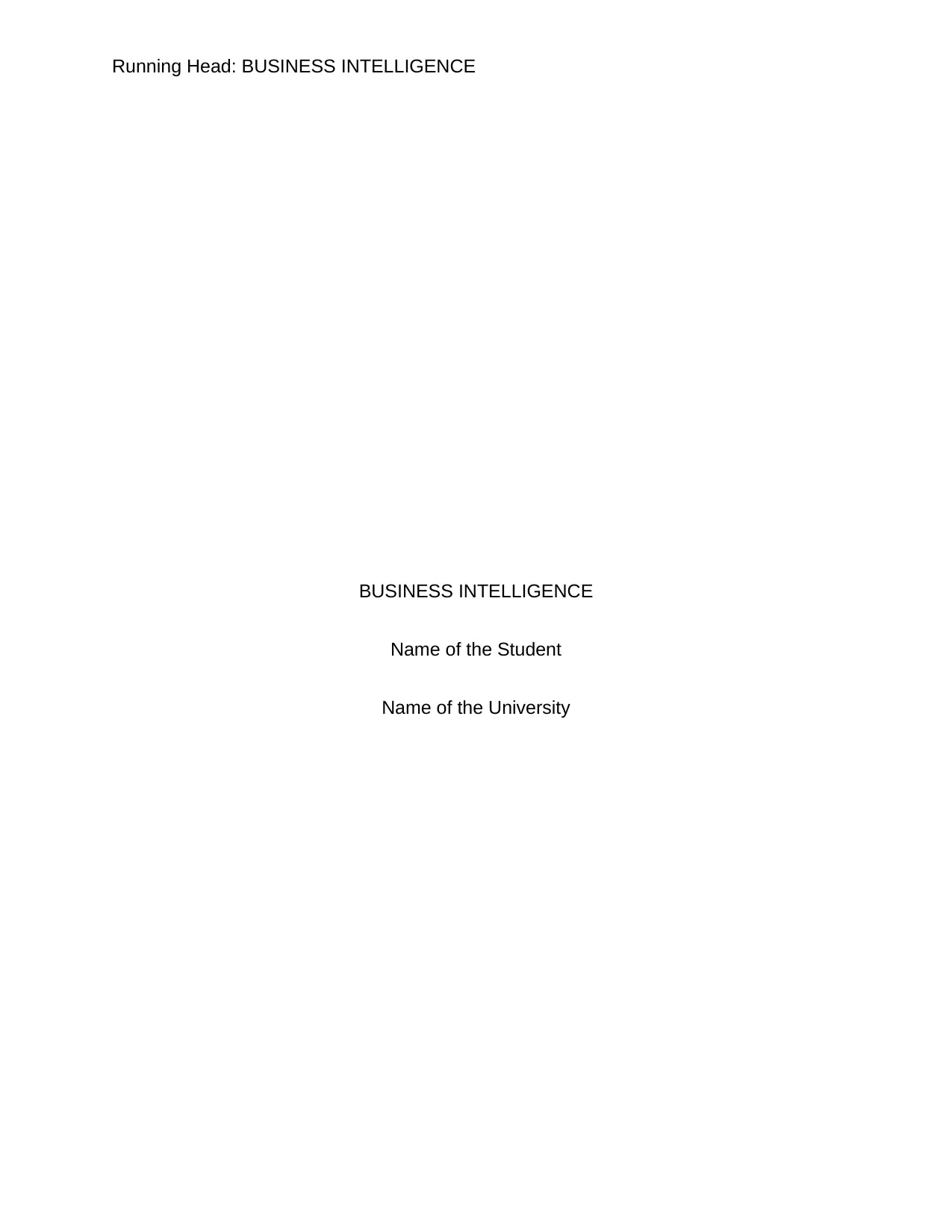
Running Head: BUSINESS INTELLIGENCE
BUSINESS INTELLIGENCE
Name of the Student
Name of the University
BUSINESS INTELLIGENCE
Name of the Student
Name of the University
Paraphrase This Document
Need a fresh take? Get an instant paraphrase of this document with our AI Paraphraser

1BUSINESS INTELLIGENCE
Executive Summary
There is a huge prospect in today’s transformation in business world, offered by the Big
Data Analytics. While this transformation in the business sectors like the marketing as
well as the financial services, world has remarkably seized the attention of researcher
and practitioners. There are more aspects in the business world where the Big Data
plays a vital role like in Supply Chain Management. With the expansion of the number of
business cases there is an increase in the complexity as well. The main aim is on the
optimization of Supply Chain Visibility that supports the decision making to handle
interruption and risk along supply chain.
Executive Summary
There is a huge prospect in today’s transformation in business world, offered by the Big
Data Analytics. While this transformation in the business sectors like the marketing as
well as the financial services, world has remarkably seized the attention of researcher
and practitioners. There are more aspects in the business world where the Big Data
plays a vital role like in Supply Chain Management. With the expansion of the number of
business cases there is an increase in the complexity as well. The main aim is on the
optimization of Supply Chain Visibility that supports the decision making to handle
interruption and risk along supply chain.

2BUSINESS INTELLIGENCE
Table of Contents
1. Introduction........................................................................................................3
2. Data Collection and Storage..............................................................................4
2.1. Data collection system................................................................................5
2.2. Storage system...........................................................................................7
3. Data in Action....................................................................................................8
3.1. Consumer-centric product design...............................................................8
3.2. Recommendation system.........................................................................11
4. Business continuity..........................................................................................12
5. Conclusion and Recommendation...................................................................16
References..........................................................................................................18
Table of Contents
1. Introduction........................................................................................................3
2. Data Collection and Storage..............................................................................4
2.1. Data collection system................................................................................5
2.2. Storage system...........................................................................................7
3. Data in Action....................................................................................................8
3.1. Consumer-centric product design...............................................................8
3.2. Recommendation system.........................................................................11
4. Business continuity..........................................................................................12
5. Conclusion and Recommendation...................................................................16
References..........................................................................................................18
⊘ This is a preview!⊘
Do you want full access?
Subscribe today to unlock all pages.

Trusted by 1+ million students worldwide
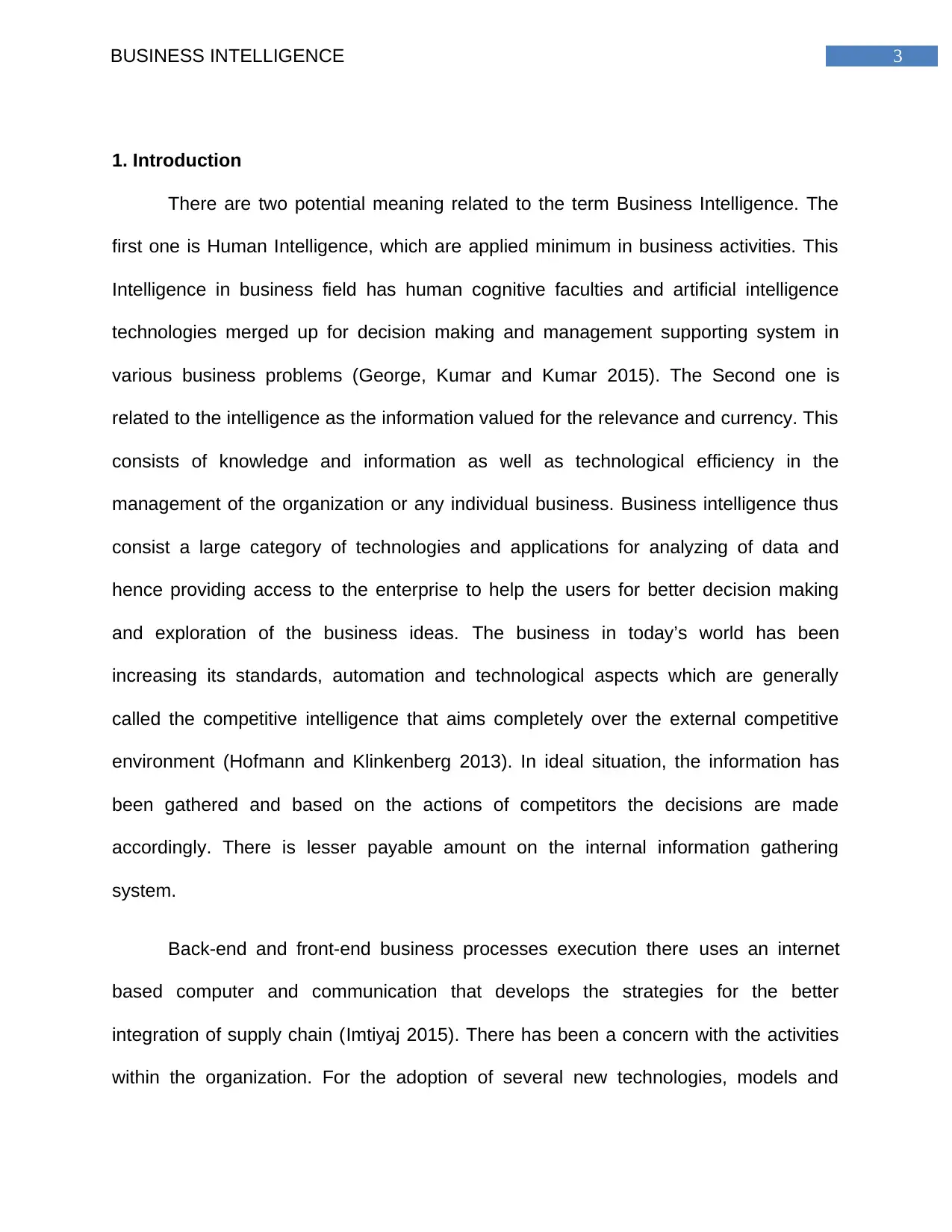
3BUSINESS INTELLIGENCE
1. Introduction
There are two potential meaning related to the term Business Intelligence. The
first one is Human Intelligence, which are applied minimum in business activities. This
Intelligence in business field has human cognitive faculties and artificial intelligence
technologies merged up for decision making and management supporting system in
various business problems (George, Kumar and Kumar 2015). The Second one is
related to the intelligence as the information valued for the relevance and currency. This
consists of knowledge and information as well as technological efficiency in the
management of the organization or any individual business. Business intelligence thus
consist a large category of technologies and applications for analyzing of data and
hence providing access to the enterprise to help the users for better decision making
and exploration of the business ideas. The business in today’s world has been
increasing its standards, automation and technological aspects which are generally
called the competitive intelligence that aims completely over the external competitive
environment (Hofmann and Klinkenberg 2013). In ideal situation, the information has
been gathered and based on the actions of competitors the decisions are made
accordingly. There is lesser payable amount on the internal information gathering
system.
Back-end and front-end business processes execution there uses an internet
based computer and communication that develops the strategies for the better
integration of supply chain (Imtiyaj 2015). There has been a concern with the activities
within the organization. For the adoption of several new technologies, models and
1. Introduction
There are two potential meaning related to the term Business Intelligence. The
first one is Human Intelligence, which are applied minimum in business activities. This
Intelligence in business field has human cognitive faculties and artificial intelligence
technologies merged up for decision making and management supporting system in
various business problems (George, Kumar and Kumar 2015). The Second one is
related to the intelligence as the information valued for the relevance and currency. This
consists of knowledge and information as well as technological efficiency in the
management of the organization or any individual business. Business intelligence thus
consist a large category of technologies and applications for analyzing of data and
hence providing access to the enterprise to help the users for better decision making
and exploration of the business ideas. The business in today’s world has been
increasing its standards, automation and technological aspects which are generally
called the competitive intelligence that aims completely over the external competitive
environment (Hofmann and Klinkenberg 2013). In ideal situation, the information has
been gathered and based on the actions of competitors the decisions are made
accordingly. There is lesser payable amount on the internal information gathering
system.
Back-end and front-end business processes execution there uses an internet
based computer and communication that develops the strategies for the better
integration of supply chain (Imtiyaj 2015). There has been a concern with the activities
within the organization. For the adoption of several new technologies, models and
Paraphrase This Document
Need a fresh take? Get an instant paraphrase of this document with our AI Paraphraser
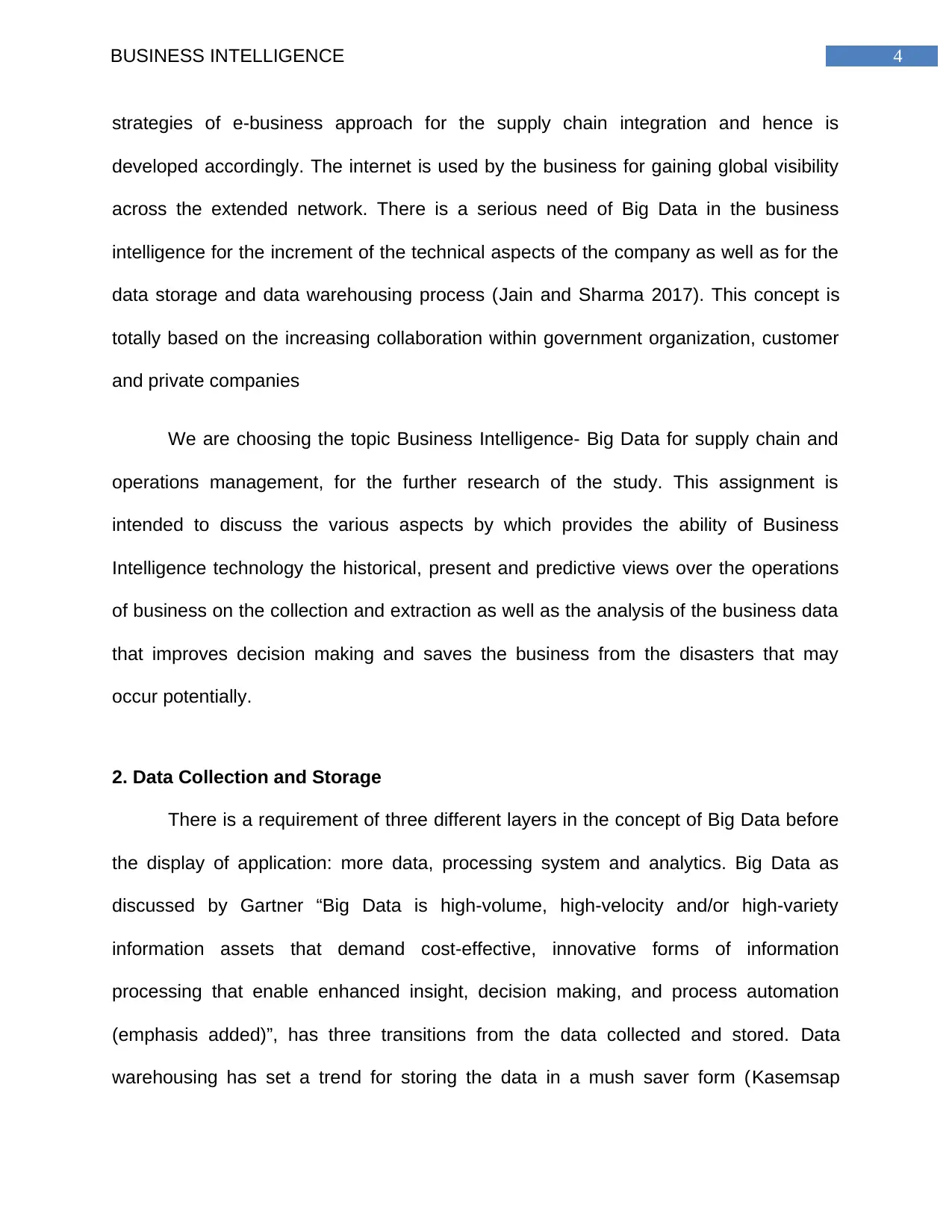
4BUSINESS INTELLIGENCE
strategies of e-business approach for the supply chain integration and hence is
developed accordingly. The internet is used by the business for gaining global visibility
across the extended network. There is a serious need of Big Data in the business
intelligence for the increment of the technical aspects of the company as well as for the
data storage and data warehousing process (Jain and Sharma 2017). This concept is
totally based on the increasing collaboration within government organization, customer
and private companies
We are choosing the topic Business Intelligence- Big Data for supply chain and
operations management, for the further research of the study. This assignment is
intended to discuss the various aspects by which provides the ability of Business
Intelligence technology the historical, present and predictive views over the operations
of business on the collection and extraction as well as the analysis of the business data
that improves decision making and saves the business from the disasters that may
occur potentially.
2. Data Collection and Storage
There is a requirement of three different layers in the concept of Big Data before
the display of application: more data, processing system and analytics. Big Data as
discussed by Gartner “Big Data is high-volume, high-velocity and/or high-variety
information assets that demand cost-effective, innovative forms of information
processing that enable enhanced insight, decision making, and process automation
(emphasis added)”, has three transitions from the data collected and stored. Data
warehousing has set a trend for storing the data in a mush saver form (Kasemsap
strategies of e-business approach for the supply chain integration and hence is
developed accordingly. The internet is used by the business for gaining global visibility
across the extended network. There is a serious need of Big Data in the business
intelligence for the increment of the technical aspects of the company as well as for the
data storage and data warehousing process (Jain and Sharma 2017). This concept is
totally based on the increasing collaboration within government organization, customer
and private companies
We are choosing the topic Business Intelligence- Big Data for supply chain and
operations management, for the further research of the study. This assignment is
intended to discuss the various aspects by which provides the ability of Business
Intelligence technology the historical, present and predictive views over the operations
of business on the collection and extraction as well as the analysis of the business data
that improves decision making and saves the business from the disasters that may
occur potentially.
2. Data Collection and Storage
There is a requirement of three different layers in the concept of Big Data before
the display of application: more data, processing system and analytics. Big Data as
discussed by Gartner “Big Data is high-volume, high-velocity and/or high-variety
information assets that demand cost-effective, innovative forms of information
processing that enable enhanced insight, decision making, and process automation
(emphasis added)”, has three transitions from the data collected and stored. Data
warehousing has set a trend for storing the data in a mush saver form (Kasemsap
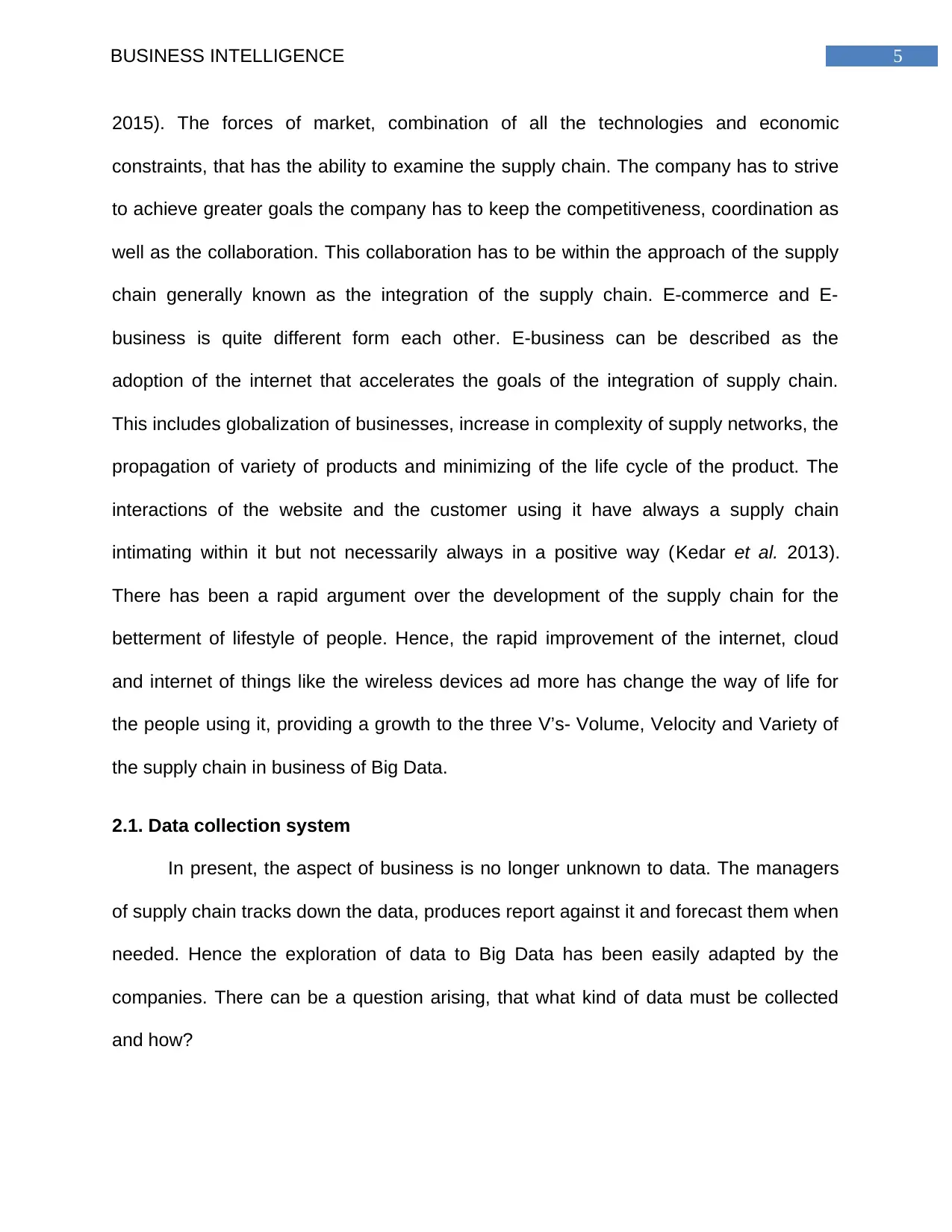
5BUSINESS INTELLIGENCE
2015). The forces of market, combination of all the technologies and economic
constraints, that has the ability to examine the supply chain. The company has to strive
to achieve greater goals the company has to keep the competitiveness, coordination as
well as the collaboration. This collaboration has to be within the approach of the supply
chain generally known as the integration of the supply chain. E-commerce and E-
business is quite different form each other. E-business can be described as the
adoption of the internet that accelerates the goals of the integration of supply chain.
This includes globalization of businesses, increase in complexity of supply networks, the
propagation of variety of products and minimizing of the life cycle of the product. The
interactions of the website and the customer using it have always a supply chain
intimating within it but not necessarily always in a positive way (Kedar et al. 2013).
There has been a rapid argument over the development of the supply chain for the
betterment of lifestyle of people. Hence, the rapid improvement of the internet, cloud
and internet of things like the wireless devices ad more has change the way of life for
the people using it, providing a growth to the three V’s- Volume, Velocity and Variety of
the supply chain in business of Big Data.
2.1. Data collection system
In present, the aspect of business is no longer unknown to data. The managers
of supply chain tracks down the data, produces report against it and forecast them when
needed. Hence the exploration of data to Big Data has been easily adapted by the
companies. There can be a question arising, that what kind of data must be collected
and how?
2015). The forces of market, combination of all the technologies and economic
constraints, that has the ability to examine the supply chain. The company has to strive
to achieve greater goals the company has to keep the competitiveness, coordination as
well as the collaboration. This collaboration has to be within the approach of the supply
chain generally known as the integration of the supply chain. E-commerce and E-
business is quite different form each other. E-business can be described as the
adoption of the internet that accelerates the goals of the integration of supply chain.
This includes globalization of businesses, increase in complexity of supply networks, the
propagation of variety of products and minimizing of the life cycle of the product. The
interactions of the website and the customer using it have always a supply chain
intimating within it but not necessarily always in a positive way (Kedar et al. 2013).
There has been a rapid argument over the development of the supply chain for the
betterment of lifestyle of people. Hence, the rapid improvement of the internet, cloud
and internet of things like the wireless devices ad more has change the way of life for
the people using it, providing a growth to the three V’s- Volume, Velocity and Variety of
the supply chain in business of Big Data.
2.1. Data collection system
In present, the aspect of business is no longer unknown to data. The managers
of supply chain tracks down the data, produces report against it and forecast them when
needed. Hence the exploration of data to Big Data has been easily adapted by the
companies. There can be a question arising, that what kind of data must be collected
and how?
⊘ This is a preview!⊘
Do you want full access?
Subscribe today to unlock all pages.

Trusted by 1+ million students worldwide
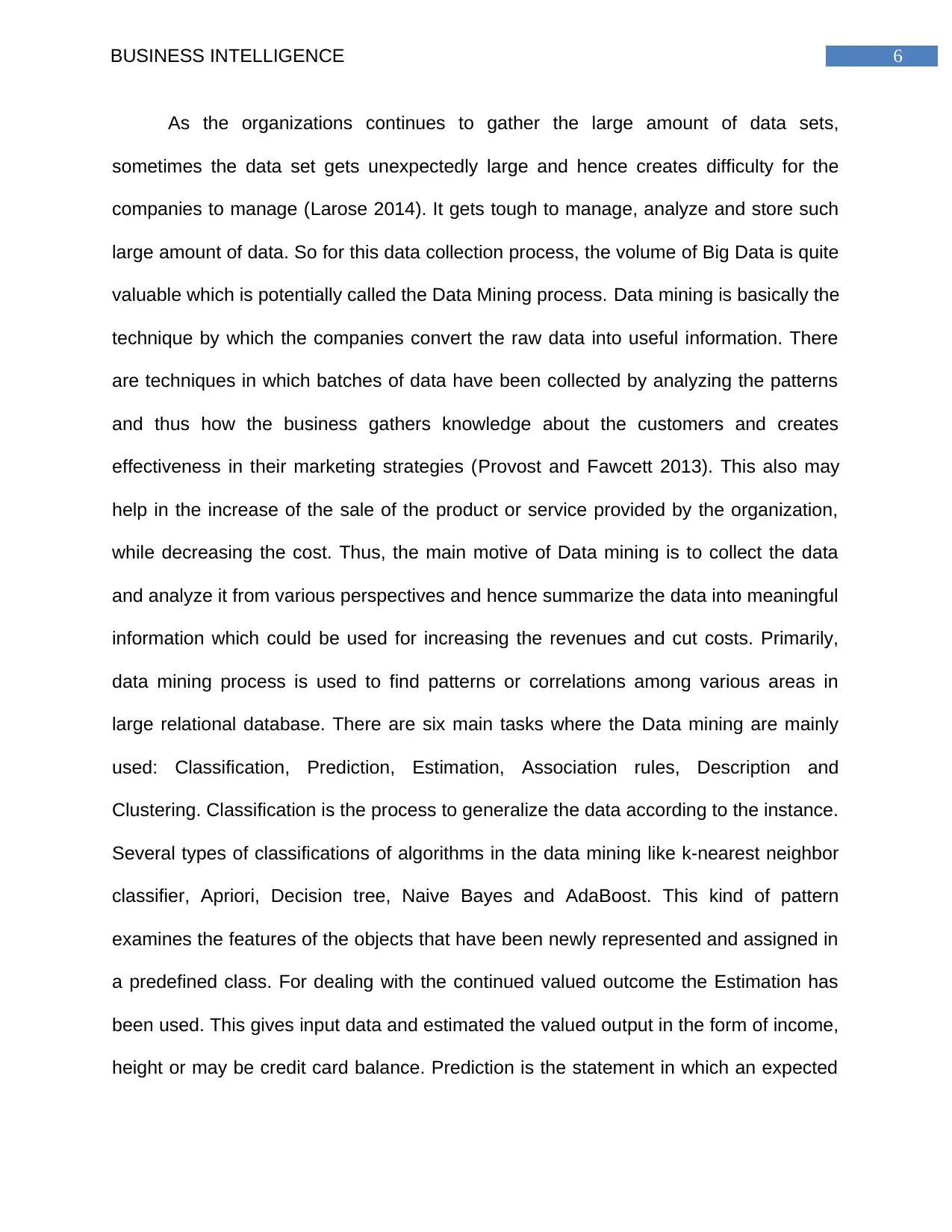
6BUSINESS INTELLIGENCE
As the organizations continues to gather the large amount of data sets,
sometimes the data set gets unexpectedly large and hence creates difficulty for the
companies to manage (Larose 2014). It gets tough to manage, analyze and store such
large amount of data. So for this data collection process, the volume of Big Data is quite
valuable which is potentially called the Data Mining process. Data mining is basically the
technique by which the companies convert the raw data into useful information. There
are techniques in which batches of data have been collected by analyzing the patterns
and thus how the business gathers knowledge about the customers and creates
effectiveness in their marketing strategies (Provost and Fawcett 2013). This also may
help in the increase of the sale of the product or service provided by the organization,
while decreasing the cost. Thus, the main motive of Data mining is to collect the data
and analyze it from various perspectives and hence summarize the data into meaningful
information which could be used for increasing the revenues and cut costs. Primarily,
data mining process is used to find patterns or correlations among various areas in
large relational database. There are six main tasks where the Data mining are mainly
used: Classification, Prediction, Estimation, Association rules, Description and
Clustering. Classification is the process to generalize the data according to the instance.
Several types of classifications of algorithms in the data mining like k-nearest neighbor
classifier, Apriori, Decision tree, Naive Bayes and AdaBoost. This kind of pattern
examines the features of the objects that have been newly represented and assigned in
a predefined class. For dealing with the continued valued outcome the Estimation has
been used. This gives input data and estimated the valued output in the form of income,
height or may be credit card balance. Prediction is the statement in which an expected
As the organizations continues to gather the large amount of data sets,
sometimes the data set gets unexpectedly large and hence creates difficulty for the
companies to manage (Larose 2014). It gets tough to manage, analyze and store such
large amount of data. So for this data collection process, the volume of Big Data is quite
valuable which is potentially called the Data Mining process. Data mining is basically the
technique by which the companies convert the raw data into useful information. There
are techniques in which batches of data have been collected by analyzing the patterns
and thus how the business gathers knowledge about the customers and creates
effectiveness in their marketing strategies (Provost and Fawcett 2013). This also may
help in the increase of the sale of the product or service provided by the organization,
while decreasing the cost. Thus, the main motive of Data mining is to collect the data
and analyze it from various perspectives and hence summarize the data into meaningful
information which could be used for increasing the revenues and cut costs. Primarily,
data mining process is used to find patterns or correlations among various areas in
large relational database. There are six main tasks where the Data mining are mainly
used: Classification, Prediction, Estimation, Association rules, Description and
Clustering. Classification is the process to generalize the data according to the instance.
Several types of classifications of algorithms in the data mining like k-nearest neighbor
classifier, Apriori, Decision tree, Naive Bayes and AdaBoost. This kind of pattern
examines the features of the objects that have been newly represented and assigned in
a predefined class. For dealing with the continued valued outcome the Estimation has
been used. This gives input data and estimated the valued output in the form of income,
height or may be credit card balance. Prediction is the statement in which an expected
Paraphrase This Document
Need a fresh take? Get an instant paraphrase of this document with our AI Paraphraser

7BUSINESS INTELLIGENCE
outcome has been explained, based on knowledge and experience but not always
applicable. The Association rule implies to the associated relationship within the set of
objects in a database system. Cluster is said to be the most vital unsupervised learning
problem.
2.2. Storage system
The data mining process extracts the raw data and processes them into useful
information, but where are these data and information are stored? These data and
information are stored in a warehouse. After centralizing the data into a meaningful
database program, it is referred as the data warehousing (Rusu, Triantafyllidis and
Kremers 2015). The data warehousing system helps in analyzing as well as utilizing of
data. It is used to support the management of decision making process.
After 1990’s, the wave of the front-end tools allows the end users to conduct
queries and hence report on available stored data in operational databases. There are
difficulties in the approach, that the tools are only effective with end users those having
knowledge about databases within medium- to high-degree.
The organizational Big Data are stored in the operational system in data
warehousing. All of the data are not transferred to the warehouse. Frequently only a
small amount of data has been transferred in the process of transformation, extraction
and load (ETL). For making the access of the end user much easier the data is
transferred in an organized manner within the warehouse as a relational database. The
activities during the data warehousing process are generally termed as the business
intelligence (Ryoo 2017). The main purpose of data warehousing is to collect and
outcome has been explained, based on knowledge and experience but not always
applicable. The Association rule implies to the associated relationship within the set of
objects in a database system. Cluster is said to be the most vital unsupervised learning
problem.
2.2. Storage system
The data mining process extracts the raw data and processes them into useful
information, but where are these data and information are stored? These data and
information are stored in a warehouse. After centralizing the data into a meaningful
database program, it is referred as the data warehousing (Rusu, Triantafyllidis and
Kremers 2015). The data warehousing system helps in analyzing as well as utilizing of
data. It is used to support the management of decision making process.
After 1990’s, the wave of the front-end tools allows the end users to conduct
queries and hence report on available stored data in operational databases. There are
difficulties in the approach, that the tools are only effective with end users those having
knowledge about databases within medium- to high-degree.
The organizational Big Data are stored in the operational system in data
warehousing. All of the data are not transferred to the warehouse. Frequently only a
small amount of data has been transferred in the process of transformation, extraction
and load (ETL). For making the access of the end user much easier the data is
transferred in an organized manner within the warehouse as a relational database. The
activities during the data warehousing process are generally termed as the business
intelligence (Ryoo 2017). The main purpose of data warehousing is to collect and

8BUSINESS INTELLIGENCE
process the data and hence analyzing the result for the solution of business problems.
Data warehousing provides the storage of metadata that may include software
programming of data, data summaries and rules for organizing data which can be easily
indexed and searched, especially using the Web tools.
There are several characteristics of Data Warehousing: Organization,
Consistency, time variant, Nonvolatile and Relational. In the organization data has been
organized by detailed subject and thus contains the information only relevant to the
decision support. There are several different codes by which the database may get
encoded, hence consistency in each manner of the warehouse (Sekaran and Bougie
2016). There are data that are kept over time such that they could be used in future
comparison and forecasting. There is a chance of new relational data to get replaced
the old data, and sometimes the data does not get updated as well. The data
warehousing uses the relational structure.
Data warehousing serves several benefits like the easier availability of data to
the users because of organized form of data which are located on specific places,
providing a consolidate view of corporate data rather than providing pieces of views
which are differently formatted and the ability to reach the data in an easier method.
3. Data in Action
There has been a significant hype around Big data and analytics, critically said
as the Data in action in business processes that helps in scaling, choosing appropriate
designs, brings change in the management system, incentives and accountability of
people (Shmueli and Lichtendahl 2017).
process the data and hence analyzing the result for the solution of business problems.
Data warehousing provides the storage of metadata that may include software
programming of data, data summaries and rules for organizing data which can be easily
indexed and searched, especially using the Web tools.
There are several characteristics of Data Warehousing: Organization,
Consistency, time variant, Nonvolatile and Relational. In the organization data has been
organized by detailed subject and thus contains the information only relevant to the
decision support. There are several different codes by which the database may get
encoded, hence consistency in each manner of the warehouse (Sekaran and Bougie
2016). There are data that are kept over time such that they could be used in future
comparison and forecasting. There is a chance of new relational data to get replaced
the old data, and sometimes the data does not get updated as well. The data
warehousing uses the relational structure.
Data warehousing serves several benefits like the easier availability of data to
the users because of organized form of data which are located on specific places,
providing a consolidate view of corporate data rather than providing pieces of views
which are differently formatted and the ability to reach the data in an easier method.
3. Data in Action
There has been a significant hype around Big data and analytics, critically said
as the Data in action in business processes that helps in scaling, choosing appropriate
designs, brings change in the management system, incentives and accountability of
people (Shmueli and Lichtendahl 2017).
⊘ This is a preview!⊘
Do you want full access?
Subscribe today to unlock all pages.

Trusted by 1+ million students worldwide
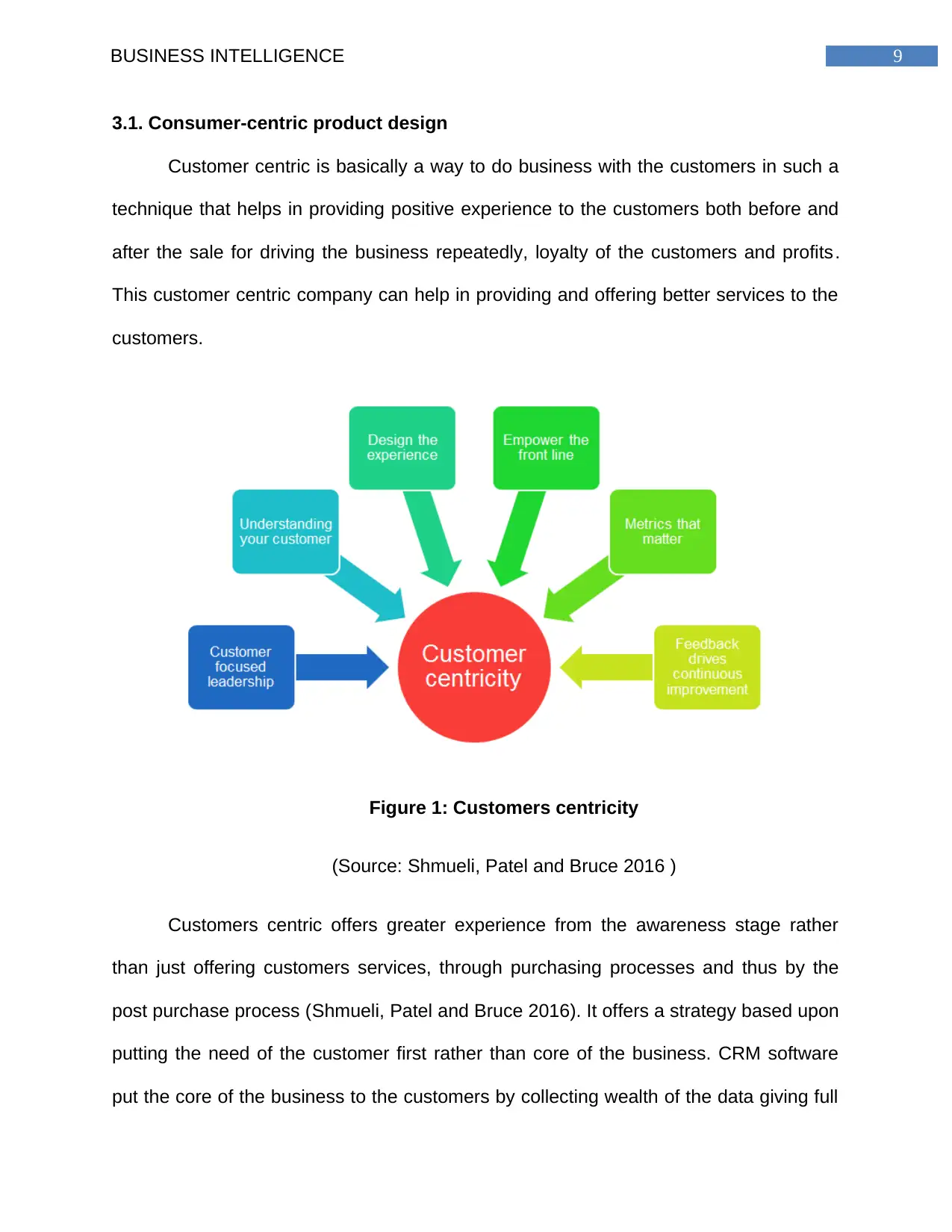
9BUSINESS INTELLIGENCE
3.1. Consumer-centric product design
Customer centric is basically a way to do business with the customers in such a
technique that helps in providing positive experience to the customers both before and
after the sale for driving the business repeatedly, loyalty of the customers and profits.
This customer centric company can help in providing and offering better services to the
customers.
Figure 1: Customers centricity
(Source: Shmueli, Patel and Bruce 2016 )
Customers centric offers greater experience from the awareness stage rather
than just offering customers services, through purchasing processes and thus by the
post purchase process (Shmueli, Patel and Bruce 2016). It offers a strategy based upon
putting the need of the customer first rather than core of the business. CRM software
put the core of the business to the customers by collecting wealth of the data giving full
3.1. Consumer-centric product design
Customer centric is basically a way to do business with the customers in such a
technique that helps in providing positive experience to the customers both before and
after the sale for driving the business repeatedly, loyalty of the customers and profits.
This customer centric company can help in providing and offering better services to the
customers.
Figure 1: Customers centricity
(Source: Shmueli, Patel and Bruce 2016 )
Customers centric offers greater experience from the awareness stage rather
than just offering customers services, through purchasing processes and thus by the
post purchase process (Shmueli, Patel and Bruce 2016). It offers a strategy based upon
putting the need of the customer first rather than core of the business. CRM software
put the core of the business to the customers by collecting wealth of the data giving full
Paraphrase This Document
Need a fresh take? Get an instant paraphrase of this document with our AI Paraphraser

10BUSINESS INTELLIGENCE
360 views to the customers. This can later be enhanced for better customer’s
experience.
Challenges faced by the business intelligence to become a customer centric
organization are: There is a power shift between brands and customers that has
happened in the economic downturn. There is a service across multiple devices and
even in real time that presents a huge challenge for many brands (Swan 2013). Thus,
the customers get much selective about spending money on brands. The brand that
gets the higher vote, earn higher priority, enhances the relationship between the
organization and customers and gains respect and reputation. And at the same time
social media marketing, recession and social selling exploded over the scene and
hence the mobile become on e of the main part of the journey of the customers.
The best practices that can be recommended to make the organization customer
centric are:
1. Customer centricity is what the brands mainly gets committed to the
customer’s need and focuses on the development of the services and
products provided around that.
2. Customer centric plan is what the brand commits about and hence
analyzes plans and implements. Customer services which are carefully
formulated are focused on creating and keeping the loyal and profitable
customers (Willis2013).
3. The brand that focuses on the customer’s centricity is mainly passionate
about the belief of the customers. The markets within the organization
360 views to the customers. This can later be enhanced for better customer’s
experience.
Challenges faced by the business intelligence to become a customer centric
organization are: There is a power shift between brands and customers that has
happened in the economic downturn. There is a service across multiple devices and
even in real time that presents a huge challenge for many brands (Swan 2013). Thus,
the customers get much selective about spending money on brands. The brand that
gets the higher vote, earn higher priority, enhances the relationship between the
organization and customers and gains respect and reputation. And at the same time
social media marketing, recession and social selling exploded over the scene and
hence the mobile become on e of the main part of the journey of the customers.
The best practices that can be recommended to make the organization customer
centric are:
1. Customer centricity is what the brands mainly gets committed to the
customer’s need and focuses on the development of the services and
products provided around that.
2. Customer centric plan is what the brand commits about and hence
analyzes plans and implements. Customer services which are carefully
formulated are focused on creating and keeping the loyal and profitable
customers (Willis2013).
3. The brand that focuses on the customer’s centricity is mainly passionate
about the belief of the customers. The markets within the organization
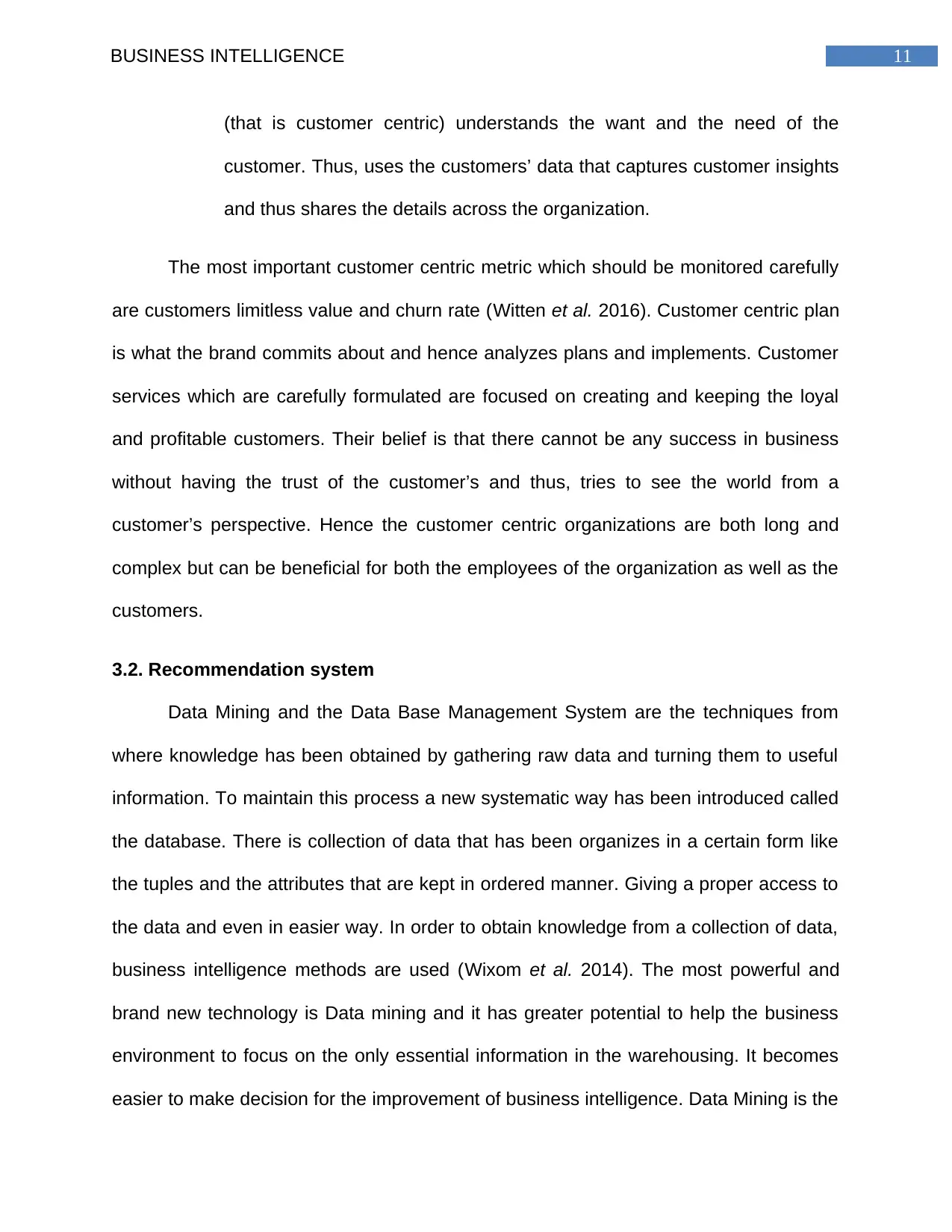
11BUSINESS INTELLIGENCE
(that is customer centric) understands the want and the need of the
customer. Thus, uses the customers’ data that captures customer insights
and thus shares the details across the organization.
The most important customer centric metric which should be monitored carefully
are customers limitless value and churn rate (Witten et al. 2016). Customer centric plan
is what the brand commits about and hence analyzes plans and implements. Customer
services which are carefully formulated are focused on creating and keeping the loyal
and profitable customers. Their belief is that there cannot be any success in business
without having the trust of the customer’s and thus, tries to see the world from a
customer’s perspective. Hence the customer centric organizations are both long and
complex but can be beneficial for both the employees of the organization as well as the
customers.
3.2. Recommendation system
Data Mining and the Data Base Management System are the techniques from
where knowledge has been obtained by gathering raw data and turning them to useful
information. To maintain this process a new systematic way has been introduced called
the database. There is collection of data that has been organizes in a certain form like
the tuples and the attributes that are kept in ordered manner. Giving a proper access to
the data and even in easier way. In order to obtain knowledge from a collection of data,
business intelligence methods are used (Wixom et al. 2014). The most powerful and
brand new technology is Data mining and it has greater potential to help the business
environment to focus on the only essential information in the warehousing. It becomes
easier to make decision for the improvement of business intelligence. Data Mining is the
(that is customer centric) understands the want and the need of the
customer. Thus, uses the customers’ data that captures customer insights
and thus shares the details across the organization.
The most important customer centric metric which should be monitored carefully
are customers limitless value and churn rate (Witten et al. 2016). Customer centric plan
is what the brand commits about and hence analyzes plans and implements. Customer
services which are carefully formulated are focused on creating and keeping the loyal
and profitable customers. Their belief is that there cannot be any success in business
without having the trust of the customer’s and thus, tries to see the world from a
customer’s perspective. Hence the customer centric organizations are both long and
complex but can be beneficial for both the employees of the organization as well as the
customers.
3.2. Recommendation system
Data Mining and the Data Base Management System are the techniques from
where knowledge has been obtained by gathering raw data and turning them to useful
information. To maintain this process a new systematic way has been introduced called
the database. There is collection of data that has been organizes in a certain form like
the tuples and the attributes that are kept in ordered manner. Giving a proper access to
the data and even in easier way. In order to obtain knowledge from a collection of data,
business intelligence methods are used (Wixom et al. 2014). The most powerful and
brand new technology is Data mining and it has greater potential to help the business
environment to focus on the only essential information in the warehousing. It becomes
easier to make decision for the improvement of business intelligence. Data Mining is the
⊘ This is a preview!⊘
Do you want full access?
Subscribe today to unlock all pages.

Trusted by 1+ million students worldwide
1 out of 20
Related Documents
Your All-in-One AI-Powered Toolkit for Academic Success.
+13062052269
info@desklib.com
Available 24*7 on WhatsApp / Email
![[object Object]](/_next/static/media/star-bottom.7253800d.svg)
Unlock your academic potential
Copyright © 2020–2025 A2Z Services. All Rights Reserved. Developed and managed by ZUCOL.





